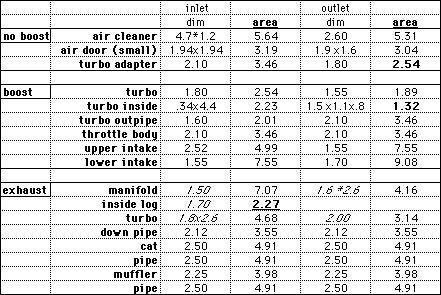

An easy way to approximate component air flow is to simply measure the size. The following chart has the sizes for the components from the air box to the exhaust tip. While this is no replacement for air flow data, clearly some components are more restrictive than others. It is important to only compare those component sizes in like environments: no boost, boost, and exhaust.
Note: The smallest area in each environment is shown in bold.

action:
porting air box, turbo inlet, turbo compressor, turbo outlet,
throttle body, butterfly
result: little change
cost: 20 hours
(incl R&R)
action:
porting exhaust manifold
result: boost 200 RPM sooner, pulls strong to 6000 rpm
details: smoothed out 4 runners, blended to "log", lowered
outlet to match turbo, blended outlet to log, made 3 & 4 as
straight as possible to outlet
cost: 15 hours
(incl R&R)
action:
new exhaust and cat
result: boost 200 RPM sooner, pulls stronger to 6000 rpm
details: weld in cat aimed fore-aft 4" behind flange, super
turbo muffler, all 2.5" pipe, all as straight as possible
cost: $200
action:
accel coil
result: no change
cost: $50
action:
jacobs plug wires
result: they work and last and have a life guarantee
cost: $50
action:
index spark plugs
result: no change
cost: $8
action:
bypass boost control solenoid
result: boost builds with rpm, not limited to 10 psi at below
4000 rpm
cost: none
details: unplug two hoses and connect with splice.
Porting details:
I use an electric Makita die grinder with CARBIDE bits and
sanding rolls. BUY A FACE SHIELD AND WEAR IT !! (cheaper
and faster than a trip to the HOSPITAL) The key to porting
is to keep the cross sectional area constant. Since our intake
manifolds are dry (no fuel) smooth helps.
I use a wire bent to the ID of the thing I'm porting, as a guide.
Use a light and your finger to assure NO LUMPS / NO DIVOTS. Grind
only what is required to keep the area constant, bigger is not
better. A step from small to larger is OK, steps from large to
small need: 15° ramp or ASME shape funnel or full radius (in order of better flow). The OUTSIDE of a
corner is much more important than the inside of the corner.
Test methodology
Per Jacobs book on ignitions there is a low cost way to quantify performance: use a stopwatch and time the changes in RPM. My quick check is to time rolling acceleration from 2000 to 6000 in 2nd, currently 6.6 sec (@60°f). I actually floor it from 1800 to 6200 to get consistent results. The time depends on outside air temp, timing, exhaust manifold temperature, and gas quality.
Caution: more power WILL make your trans et al wear out quicker AND most of these changes void CA smog laws.(Glad for lazy politicians -WebMaster ;-)

